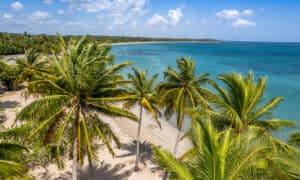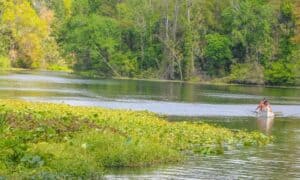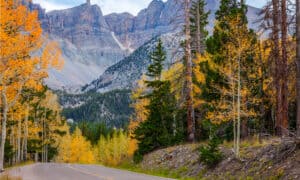Minnesota has a vast wilderness, with landscapes protected by several national parks. These parks are home to diverse fish and animal species such as eagles, coyotes, loons, and elk. Many aquatic and semi-aquatic animals also call these regions home, from salmon to beavers and river otters. While these parks protect these lands, mercy consumption has become a growing concern for many aquatic animals. A study from the journal Environmental Science Technology found mercury hurts fish species like salmon and the animals that prey on them, such as bears.
1. Grand Portage National Monument

Grand Portage National Monument covers 710 acres of land.
©iStock.com/lynngrae
| Grand Portage National Monument | |
|---|---|
| Size | 710 acres |
| Animal to see | Beavers |
| Attraction to see | Lake Superior |
The Grand Portage State Park preserves 710 acres in a semi-wilderness setting in Minnesota. The monument on this property is on the National Register of Historic Places because of its historical significance in the fur trade and exploration during the northwest’s colonization.
Preserved with the Grand Portage monument are the historic depots located on Lake Superior, the Pigeon River, the Grand Portage (connecting the two depots), and the site of Fort Charlotte. Most of this park’s semi-wilderness setting is contained within Fort Charlotte and the 8.5-mile Portage corridor.
The Grand Portage State Park encompasses a wild and diverse landscape. The wilderness changes with every 100 feet of elevation above the lake and every mile away from its reach. Throughout the park, you may be able to see beavers, the most popular animal on the land. Beavers were one of the most important animals during the fur trade and can be seen frolicking near the water or adjacent to some of the trails at this historic site.
2. Mississippi National River and Recreation Area
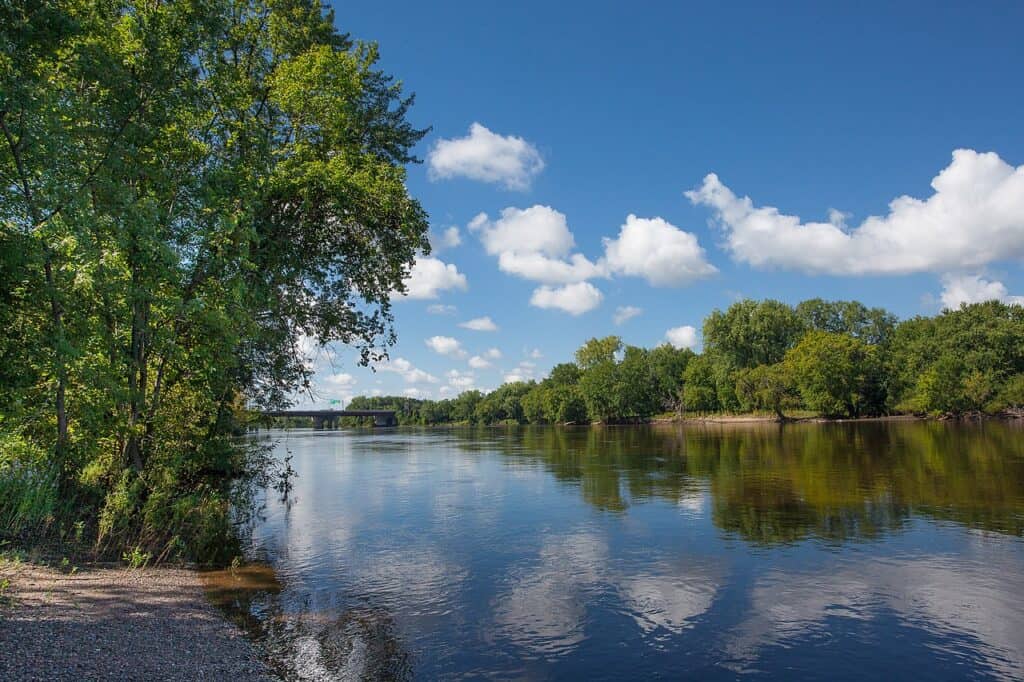
Mississippi National River and Recreation Area covers 54,000 acres of land.
©NPS/Gordon Dietzman / Public Domain – License
| Mississippi National River and Recreation Area | |
|---|---|
| Size | 54,000 acres |
| Animal to see | Coyote |
| Attraction to see | Mississippi River |
Though nestled in the middle of a bustling city, the 72-mile river park that is the Mississippi National River and Recreation Area offers a quiet, serene atmosphere that is known for fishing, boating, bird watching, and hiking. There are multiple visitor’s centers and trails where you can learn about the fascinating human history that goes along with this national park.
Along these trails, you can see various wildlife that resides in this gorgeous ecosystem. These creatures include more than a hundred fish species and a recovering mussel population. You can also find coyotes, otters, deer, muskrats, beavers, and other mammals along the river’s banks.
The park continually assesses the quality of life of the animals that reside here by doing routine checks of the varying regions of the park.
3. Chippewa National Forest/North Country
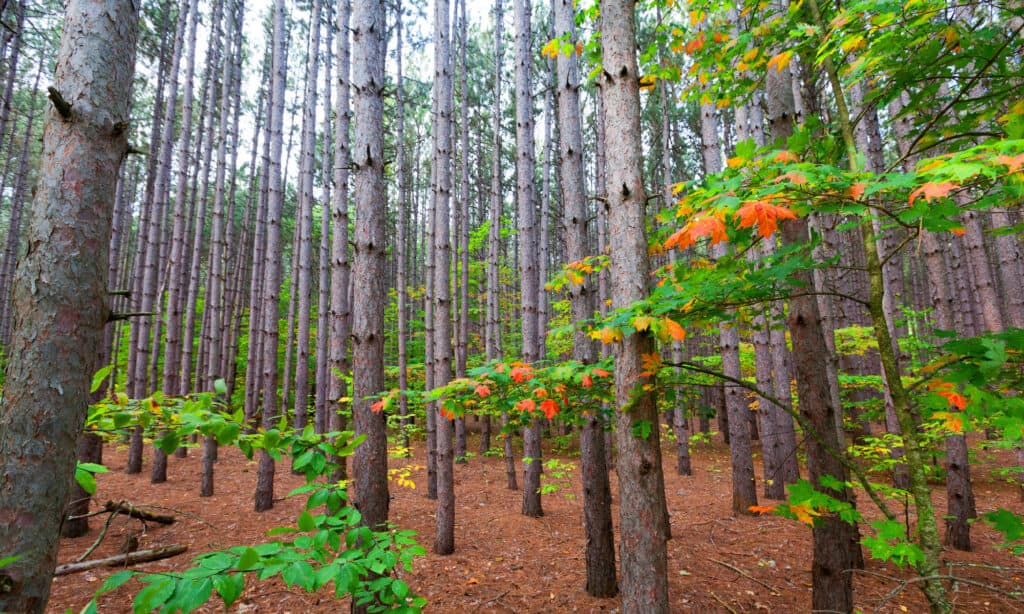
The Chippewa National Forest in north-central Minnesota currently holds 61 miles of the North Country National Scenic Trail.
©iStock.com/csterken
| Chippewa National Forest/North Country | |
|---|---|
| Size | 667,000 acres |
| Animal to see | Elk |
| Attraction to see | North Country Trail |
The Chippewa National Forest in north-central Minnesota currently holds 61 miles of the North Country National Scenic Trail. The North Country is a series of hills and valleys that stretch through multiple states in the United States of America, including Minnesota. The land includes shores of lakes and streams from glaciers 10,000 years old.
Here, you will find clear-flowing water and open prairies covering distant horizons that gleam over this historic land. Historic sites alongside the trails tell the story of how America today came to be. You can find many diverse animal species throughout these beautiful hills and valleys, including conifer-dependent birds, wolves, bison, elk, and even mountain goats.
Though Minnesota is not the only state that the North Country graces, it should be noted as being one of the most recent to take on beautification projects along the trails in the state, providing much-needed assistance to the wildlife inhabiting this ever-stretching land.
4. Pipestone National Monument
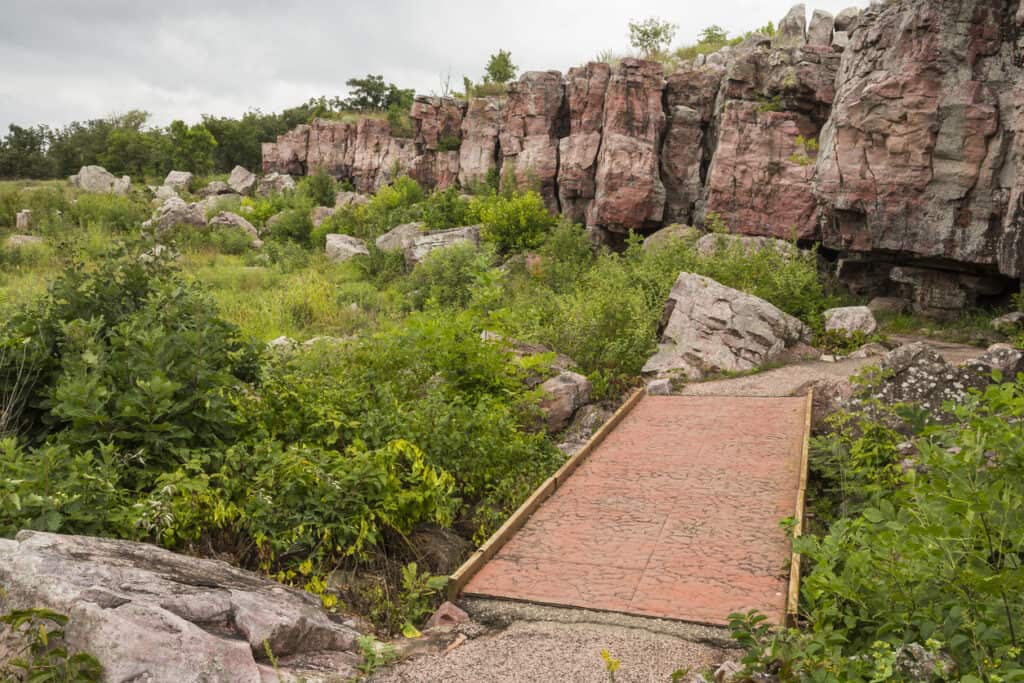
Pipestone National Monument offers a diverse array of animal species, including squirrels, snapping turtles, great blue herons, and beavers.
©iStock.com/John_Brueske
| Pipestone National Monument | |
|---|---|
| Size | 281.78 acres |
| Animal to see | Blue heron |
| Attraction to see | Pipestone Cultural Demonstrators |
The Pipestone National Monument has been a place of great respect for Native American populations for countless generations. The native people quarried the red pipestone found at this site to carve into pipes used for prayer, believing that the pipe smoke would carry prayers to the Great Spirit. The traditions of quarrying and pipemaking continue at this site today, and when visiting the land, you can hear stories of the sacred grounds preserved here.
Pipestone National Monument offers a diverse array of animal species, including squirrels, snapping turtles, great blue herons, and beavers. Bird watching is a popular activity for those who wish to visit the site, as it is the habitat of over 100 bird species.
5. Saint Croix National Scenic Riverway

Saint Croix National Scenic Riverway offers a wide variety of activities such as paddle boarding, tubing, boating, and fishing.
©iStock.com/scgerding
| Saint Croix National Scenic Riverway | |
|---|---|
| Size | 92,738 acres |
| Animal to see | Northern shrew |
| Attraction to see | St. Croix National Riverway |
Saint Croix National Scenic Riverway is home to the St. Croix and Namekagon rivers and offers a wide variety of activities such as paddle boarding, tubing, boating, fishing, and camping along the scenic and wild beauty of the park.
Many people come to the park to hike along the historic trails and witness the vast wildlife. The rivers offer over 200 miles of clean water rushing through a forested landscape that is home to many thriving animal species.
The nature you can find in the park ranges from tiny northern shrews to widely seen beavers, coyotes, otters, and white-tailed deer. Rarely, individuals in the park may also come across mountain lions or black bears.
6. Voyageurs National Park

Voyageurs National Park is one of the most diverse and plentiful national parks in the United States.
©iStock.com/BlueBarronPhoto
| Voyageurs National Park | |
|---|---|
| Size | 218,200 acres |
| Animal to see | Grey wolf |
| Attraction to see | Northern Lights |
Voyageurs National Park is arguably one of the most diverse and plentiful national parks in the United States. It is full of exposed cliffs, rock ridges, wetlands, streams, forests, and lakes. It is a land of transition between land and aquatic ecosystems, wild and developed landmass, and southern and northern forest atmospheres. One of the most popular attractions you can see when adventuring through the trails of Voyageurs National Park is the elusive Northern Lights.
The Boreal forest, home to the Voyageurs National Park, is diverse in tree and plant species as well as wildlife. Here, you can find more than 100 species of birds and over 50 species of mammals. You’ll also notice a diverse range of amphibians.
Of the many species of animals located in the national park, you may find moose, beavers, grey wolves, loons, eagles, or even a Double-Crested Cormorant. The options are endless, with terrain as vast and diversified as the one found in Voyageurs National Park.
The photo featured at the top of this post is © iStock.com/scgerding
Thank you for reading! Have some feedback for us? Contact the AZ Animals editorial team.



